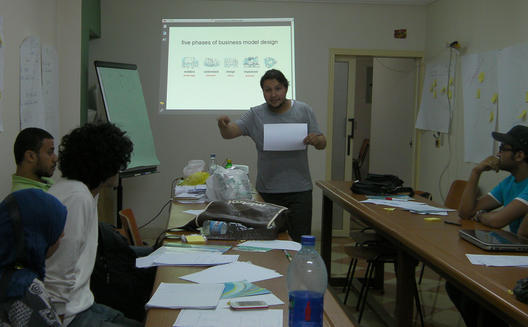How to Use a Cow Creatively: Social Entrepreneurship Gets Innovative in Egypt

 Ever wondered how to start a social
enterprise and change the world?
Ever wondered how to start a social
enterprise and change the world?
JCI Cairo recently brought in Moroccon expert Adnane Adioui, founder of the Moroccan Center For Innovation and Social Entrepreneurship, to run a “Social Entrepreneurship and Social Business Models” two-day course at the El-Mahrousa Center for Socio-economic Development.
JCI is an international nonprofit organization that develops its members into “young active citizens"- past members include Kofi Annan and Bill Clinton. It has branches globally, with JCI Egypt being the latest addition.
Adnane is a certified JCI trainer and member of JCI Rabat, and he designed this course three years ago because “no guides were available locally at the time.” This was the first time he’s delivered the course in Egypt, as part of his new life as a social entrepreneur, and it's his tenth time overall. The course, and his consultancy service, is available for free to charities and social enterprises, and for a fee to corporations.
The first day of the course was pure theory. You won’t be surprised to read that starting a social enterprise is very much like starting a regular one, the main difference being that the focus is on social good instead of profit – although profit is good for society too, of course.
Adnane explained the Lean Canvas business model design method, an idea based upon Alex Osterwalder's Business Model Canvas which is getting very popular lately (read Kia Davis's review here and Abdullah AlShalabi's summary of a Startup Q8 presentation that featured it). The Lean Canvas technique asssesses a business in terms of its partner network, key activities, key resources, cost structure, offer, customer relationships, customer segments, channels, and revenue streams.
Adnane also spoke about innovative thinking. He believes that everyone is innovative, but frequently the only way to “ignite the innovation” is to put people in a group, immerse them out of their comfort zone, and “force” them to come up with new ideas, in this case for social innovation.
The second day was practical, and comprised various exercises that tested what the participants had learnt the day before. In one fun exercise, people were split into teams of three and asked to come up with three business models that used a cow in a non-traditional way – i.e. not through involving dairy or meat products – to solve social problems. “How can a cow save the World?” Adnane asked with a grin.
The ideas the teams ultimately came up with weren’t very new but were good enough, the best being using cow dung as a green energy source, and using the cow itself as a tourist attraction by painting it or making it predict football scores! Adnane also gave us some global examples of real-life innovative cow use, the best two being the use of cows as advertising billboards, or as rentable pets!
In the last exercise, participants were given an hour to come up with “a project from A to A; a business model that fixes a local social problem.”
When it came time to present the projects at the end, the teams did their best to be negative about each other, even getting into arguments about why the other’s ideas would fail. Adnane was visibly disappointed; he’s not accustomed to the modern Egyptian lack of debating skills and intolerance of difference. “If we can’t organize our debate or conversations, then we won’t be able to organize a social enterprise,” he said loudly.
This modern Egyptian malaise is at the heart of most problems here, and it’s the reason we need more enterprise, entrepreneurship, innovative thinking, and the ability to simply listen to someone’s point of view. To be fair, with more and more events like this, Egypt is already changing for the better.


